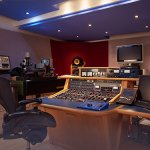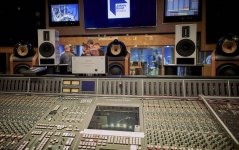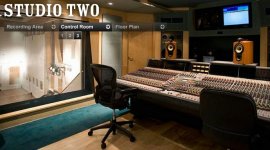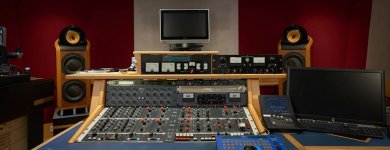I noted the depletion of delayed signals in the impulse when foam was added to the waveguide.
Dampening material is the same technique used to remove modes from the transmission line behind the diapragm ...so it should work in front of the diapragm as well, as the physics see no difference in a line in front or behind the source.
I didn't agree with Geddes in my thread to chose a waveguide (off the bat) for my design, but I acknowledge that he is right in the pursuit of scientific sq (ir etc)....basically that...all modes are bad modes...not literally but if there is no need for a mode to be there...then why have it be there...(using modes to decrease IMD debate)
For the type of modes that comprise HOM in a waveguide are you guys just measuring on axis? If I follow the thought train that every crest and trough is a propagation mode or destructive mode maybe this exposes the fundamental of the modes in search of
.The modes always exist, but get excited to a variable degree depending on the nature of the wavefront.
I would have to move the microphone around because from the pictures I've seen...if they apply...they don't always live on axis....just wondering if you guys are doing this in combination with the measurements you are taking....
Waveguides are designed to have minimal modes....the modes of a horn is obviously stronger....probably due to lower frequency modes, in some type of way, being more energetic? or whatever part of physics that cause higher frequencies to have shorter decay time. I didn't agree with Geddes in my thread to choose a waveguide (off the bat) for my design, but I acknowledge that he is right in the pursuit of scientific sq (ir etc)....basically that...all modes are bad modes...not literally but if there is no need for a mode to be there...then why have it be there...which is likely why waveguides were the next progression after the traditional horn.In this thread, since the intent is to minimize these modes, they will be very hard to find - that's the intent!
Attachments
Last edited:
Getting the right balance of indirect energy at the right time and from the right direction with the right spectrum is a tricky thing to do and is one area where musical style and personal preference play a large part in what one individual may pick that another does not like at all.
The infamous 2 words... again.
It is just a sign that science has yet some way to go. While we have some grip on it while in the electrical representation, there is a long way to master the acoustical aspects of sound recording/reproduction. While this last, we have to accept that personal opinions will play a big role. There is actually a long way to go still.
//
//
I think speaker design has done a lot so far...maybe its time to focus on the room...isn't that what cardioid is about? making the room less apart of the equation? Same could be said for controlled directivity via horn or waveguide.
We seem to either aim at feeding the room accurate frequency or take one step closer to removing the room or both.
Still even that is a narrow view leaving out omnidirectional speakers.....yet!...in nature, outside that is...indirect energy is much much lower. Om some type of level nature (outdoors) is likely a main reference point for correct, and we create windows into that with narrow polars that keep indirect energy low.
We seem to either aim at feeding the room accurate frequency or take one step closer to removing the room or both.
Still even that is a narrow view leaving out omnidirectional speakers.....yet!...in nature, outside that is...indirect energy is much much lower. Om some type of level nature (outdoors) is likely a main reference point for correct, and we create windows into that with narrow polars that keep indirect energy low.
Last edited:
It's hard enough to get a decent sounding pair of speakers into a room... changing the entire room to sound better... tough sell.
I'd be happy seeing recording engineers get rid of those massive consoles and set up their speakers like you would in a normal listening room. This would better match the average home listener. Do they even use all those sliders and dials??
Even at Abbey Road, the (not great) BMW 800s are barely poking over the console. The one with the red background is their 'vinyl mastering room'
A pair of waveguides properly designed in ath. properly placed in a regular livingroom are going to blow away what those engineers are listening to.
I'd be happy seeing recording engineers get rid of those massive consoles and set up their speakers like you would in a normal listening room. This would better match the average home listener. Do they even use all those sliders and dials??
Even at Abbey Road, the (not great) BMW 800s are barely poking over the console. The one with the red background is their 'vinyl mastering room'
A pair of waveguides properly designed in ath. properly placed in a regular livingroom are going to blow away what those engineers are listening to.
Attachments
Last edited:
Read Newall & Holland' High Performnce Loudspeakers about (their!) in-wall mounted dedicated Studio Monitors (as opposed to the average Monkey Coffins for the deaf).
yup and then they want the esoteric stuff that we don't believe or agree on that exists/works....Do they even use all those sliders and dials??
I'd be happy seeing recording engineers get rid of those massive consoles and set up their speakers like you would in a normal listening room. This would better match the average home listener. Do they even use all those sliders and dials??
A pair of waveguides properly designed in ath. properly placed in a regular livingroom are going to blow away what those engineers are listening to.
Until we have brain-to-computer interfaces we do need a desk with a monitor (screen) on it etc to actually work on sound recordings / creation, whether there's a big console or not. And that absolutely is a huge problem most people actually are very aware of. There's just not much you can do. Unlike in creation or mixing rooms, many mastering rooms do go out of their way to avoid exactly this by angling or otherwise acoustically hide the needed gear. Again, this is a huge problem. But on the other hand the comb filtering this introduces when the speakers are behind the desk with some distance is perceptually fairly benign. Unlike having speakers actually on the desk, that truly wreaks havoc, but unfortunately is very common especially in smaller studios.
And also to be fair, the worst problem in rooms is usually in the bass region and that is taken care of in a professional environment to the degree the situation / budget allows. I would much rather have an objekt obstructing the direkt sound field with its combfiltering compared to the abysmal bass performance of a standard living room. But it definitely is a problem with no solution for the time being.
While this last, we have to accept that personal opinions will play a big role.
I would not agree to "big role."
I might say this differently:
At the extremes of high performance, personal preferences for music types may dictate different approaches, but these are not major issues since, by far, the vast majority of preferred metrics are common among all listeners. Only as one has resolved known issues like frequency response, directivity control, etc. will the differences in perception bias (like level of DI, or flatness of DI,) enter into the equation. All agree that a smooth DI and a smooth FR are essential and not until other things have been brought under control will these factors even become significant.
But it definitely is a problem with no solution for the time being.
I also don't think that this is true since we know how to solve that problem as well. It's just not done very often.
Ok - I see what you mean and I do agree within the realm of what is seen as SOTA today. But to me, there is a very long way to go to a completely thrilling reproduction of Mahler 4th as experienced in a concert hall. This is my reference and my goal. For that to happen, a capture-reproduction architecture is in need to be defined that can achieve the above. Whit that in mind I wrote "big role" as not many go regularly to experience natural non-amplified instruments so "good sound" is an opinion what sounds "nice" rather than correct.
//
//
Until we have brain-to-computer interfaces we do need a desk with a monitor (screen) on it etc to actually work on sound recordings / creation, whether there's a big console or not.
Yes, I of course understand this. But I'm sure with modern tech there are less obtrusive solutions. There are studios that do it. I see the massive analog console as almost a mark of status, like doctors wearing the stethoscope even if it could just as well sit in their office along with their other instruments.
But on the other hand the comb filtering this introduces when the speakers are behind the desk with some distance is perceptually fairly benign.
I disagree with this. Having nothing between the speakers, and from speakers to listener makes a big difference verses having sources of diffraction. I found this out when I removed all sources of diffraction within 'the triangle' in my own listening room.
Anyways, I'm off topic.
Last edited:
Ok - I see what you mean and I do agree within the realm of what is seen as SOTA today. But to me, there is a very long way to go to a completely thrilling reproduction of Mahler 4th as experienced in a concert hall. This is my reference and my goal. For that to happen, a capture-reproduction architecture is in need to be defined that can achieve the above. Whit that in mind I wrote "big role" as not many go regularly to experience natural non-amplified instruments so "good sound" is an opinion what sounds "nice" rather than correct.
//
"SOTA"?
But you make exactly my point, the details come down to musical preference not transducer sound quality and rooms. I have been to many live concerts and they don't thrill me like a good studio recording and film. I, personally, find them kind of dull. Hence we have a personal preference bias along certain directions based on our musical tastes.
But what I'm saying is that our metrics for the reproduction side will be extremely close up until our musical preferences become significant biases.
As a researcher into perception, I don't like to hear people say things like "It's all up to personal taste" as the facts just don't bear that out. Just read Toole and Olive. We know a lot these days.
I disagree with this. Having nothing between the speakers, and from speakers to listener makes a big difference verses having sources of diffraction. I found this out when I removed all sources of diffraction within 'the triangle' in my own listening room.
Anyways, I'm off topic.
Of topic maybe, but I strongly agree with this. I have lots of measurements that show things in front of you create big problems. Even between the speakers.
Ok - I see what you mean and I do agree within the realm of what is seen as SOTA today. But to me, there is a very long way to go to a completely thrilling reproduction of Mahler 4th as experienced in a concert hall.
I frequent concert halls and arenas (pre-covid). My home system is at the point today where I often feel it's a better listening experience than live. Many times I've left a show and thought... "that probably would have sounded better at home." I don't know, maybe I'm just weird like that. I like being able to control the volume too. It's certainly better for any type of amplified music. I've just gone off on recording engineers, don't get me started on live PA...
Last edited:
I disagree with this. Having nothing between the speakers, and from speakers to listener makes a big difference verses having sources of diffraction. I found this out when I removed all sources of diffraction within 'the triangle' in my own listening room.
I think I stated about three times explicitly that this IS a problem ;-) All I was saying is that in comparison with the average living room with its say 15dB variations in bass response it is for me the smaller problem (just to counter the argument that the average listener has better listening conditions than the professionals with their silly gear). I never said it wasn't one. And it seems quite obvious to me that if you have the choice you DON'T put anything between you and the speakers.
"SOTA"?
But you make exactly my point, the details come down to musical preference not transducer sound quality and rooms. I have been to many live concerts and they don't thrill me like a good studio recording and film. I, personally, find them kind of dull. Hence we have a personal preference bias along certain directions based on our musical tastes.
But what I'm saying is that our metrics for the reproduction side will be extremely close up until our musical preferences become significant biases.
As a researcher into perception, I don't like to hear people say things like "It's all up to personal taste" as the facts just don't bear that out. Just read Toole and Olive. We know a lot these days.
State of the Art.
I disagree - you misunderstood what I was saying. It is not at all about musical preference and artificial thrill. I love concert halls. And yes - they sound experience in them are very different from what you get at home. This is my problem - todays systems cannot recreate reality i.e. a music event in a hall.
Well, if you feel that what you get is what you hear at a live performance in a concert hall - fine for you. I either don't have the gear or you are more pleased with what you hear at home. It seems to be the latter as you say you dont like reality.
Anyways - my comment was about reality but as most rather have nice sound so for me it ends up in "personal taste" - be it individual or a mass movement 🙂
It can be really good - but still very far away really...
//
Last edited:
I also don't think that this is true since we know how to solve that problem as well. It's just not done very often.
Well if you have a solution for putting a desk with several screens, keyboard, controllers, gear etc in-between the person and the speakers in a way they do not negatively impact the sound, please let me know. In mastering rooms it is indeed done sometimes, but that's a specialty scenario.
For the people who work with picture and sound it gets even worse as the large screen and center channel like to occupy the same space. Unless you're working in a large dubbing stage where the image is projected onto an acoustically transparent screen, this is a huge basically unsolvable problem.
Off topic again, but one reason I prefer asymmetric waveguides in a studio situation, even if only they take up less space vertically in a space where every inch counts as the worse vertical dispersion can be dealt with whereas there's nothing that can be done about the space limitations. This is of course far from optimal, but unavoidable.
I think I stated about three times explicitly that this IS a problem ;-) All I was saying is that in comparison with the average living room with its say 15dB variations in bass response it is for me the smaller problem (just to counter the argument that the average listener has better listening conditions than the professionals with their silly gear). I never said it wasn't one. And it seems quite obvious to me that if you have the choice you DON'T put anything between you and the speakers.
Yes it seems obvious, but doesn't seem to be put into practice.
For bass - modern consumer grade receivers have multi-sub outputs with measurement mics and high resolution correction filters. It's getting pretty easy to get good bass in a livingroom.
Last edited:
- Home
- Loudspeakers
- Multi-Way
- Acoustic Horn Design – The Easy Way (Ath4)





